IHP604 Healthcare Quality Improvement: Infection Rate Analysis & EHR
VerifiedAdded on 2023/03/29
|15
|1479
|303
Presentation
AI Summary
This presentation analyzes infection rate data related to central line-associated bloodstream infections (CLABSIs), catheter-associated urinary tract infections (CAUTIs), and surgical site infections (SSIs) after colon surgery, utilizing data collected by healthcare professionals and stored in Electronic Health Records (EHR). The presentation examines the fields in the EHR used for data collection, the impact of meaningful use on data collection, and the implications of not collecting the data. An analysis of patient care quality from 2015 to 2016 reveals a degradation in care quality based on infection rates. The presentation concludes by discussing the crucial role of leadership in disseminating information and identifying strategies to reduce infection rates, emphasizing the importance of clinical alarms, data analysis, and therapeutic decision support.
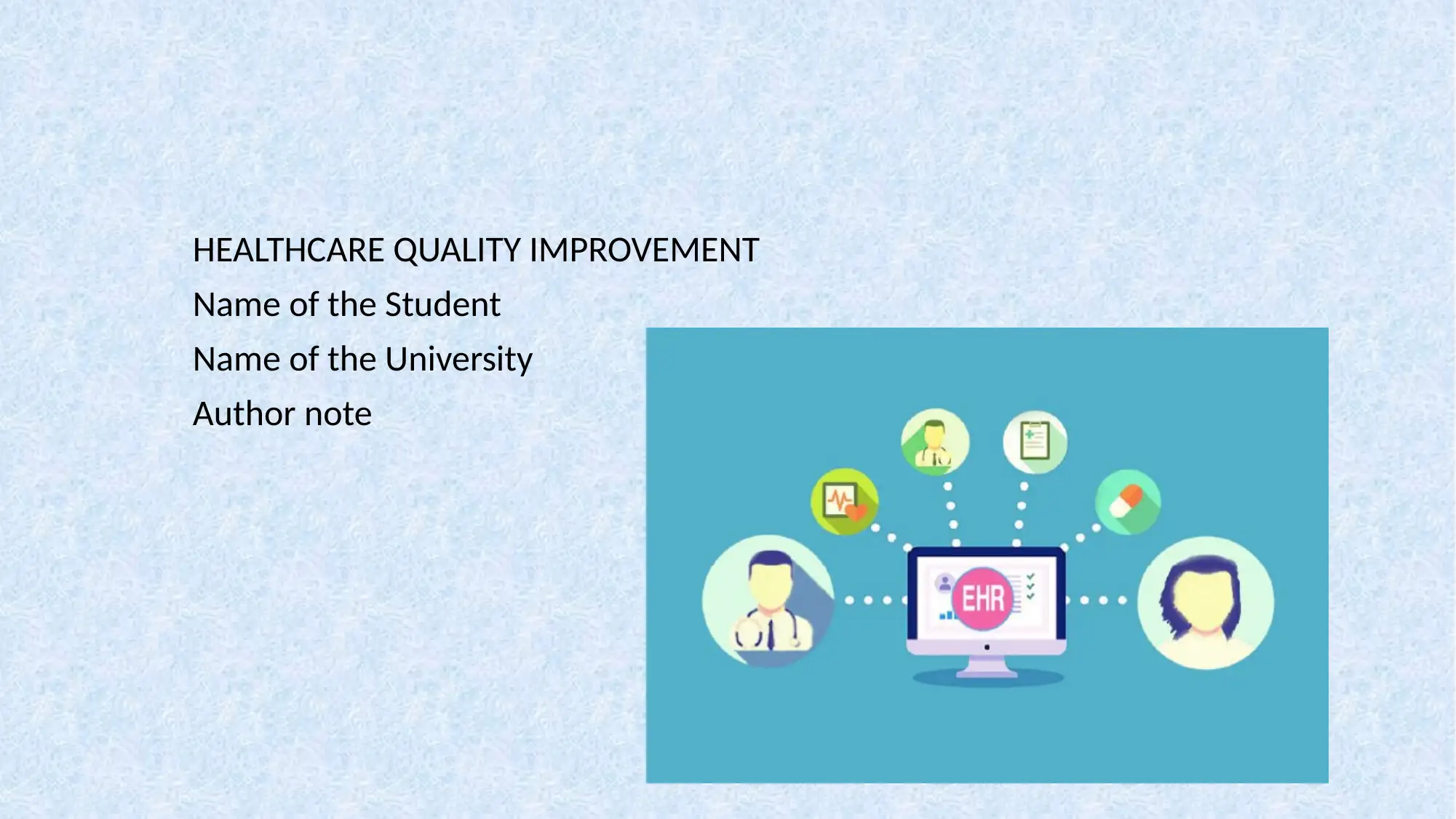
HEALTHCARE QUALITY IMPROVEMENT
Name of the Student
Name of the University
Author note
Name of the Student
Name of the University
Author note
Paraphrase This Document
Need a fresh take? Get an instant paraphrase of this document with our AI Paraphraser
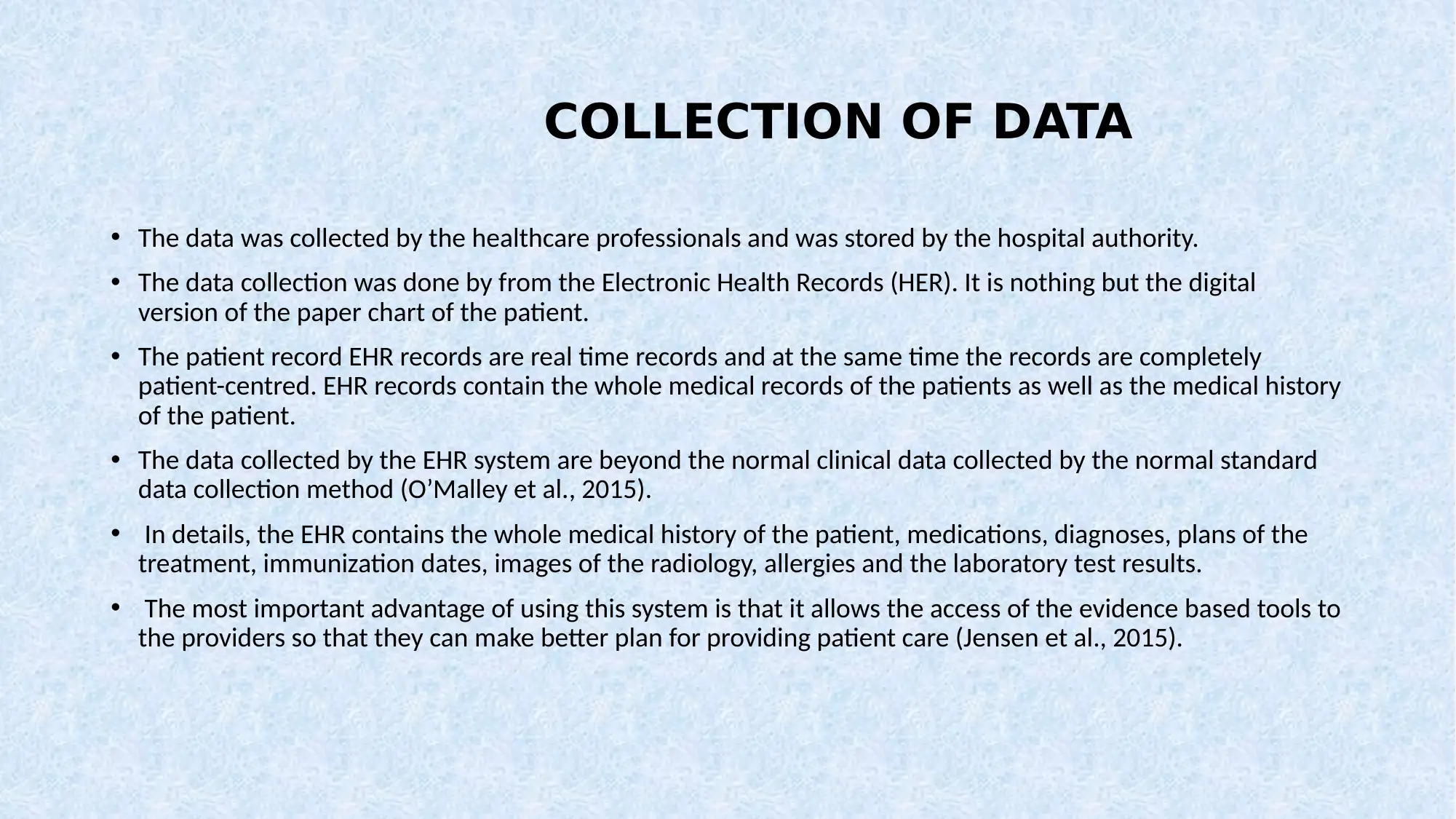
COLLECTION OF DATA
• The data was collected by the healthcare professionals and was stored by the hospital authority.
• The data collection was done by from the Electronic Health Records (HER). It is nothing but the digital
version of the paper chart of the patient.
• The patient record EHR records are real time records and at the same time the records are completely
patient-centred. EHR records contain the whole medical records of the patients as well as the medical history
of the patient.
• The data collected by the EHR system are beyond the normal clinical data collected by the normal standard
data collection method (O’Malley et al., 2015).
• In details, the EHR contains the whole medical history of the patient, medications, diagnoses, plans of the
treatment, immunization dates, images of the radiology, allergies and the laboratory test results.
• The most important advantage of using this system is that it allows the access of the evidence based tools to
the providers so that they can make better plan for providing patient care (Jensen et al., 2015).
• The data was collected by the healthcare professionals and was stored by the hospital authority.
• The data collection was done by from the Electronic Health Records (HER). It is nothing but the digital
version of the paper chart of the patient.
• The patient record EHR records are real time records and at the same time the records are completely
patient-centred. EHR records contain the whole medical records of the patients as well as the medical history
of the patient.
• The data collected by the EHR system are beyond the normal clinical data collected by the normal standard
data collection method (O’Malley et al., 2015).
• In details, the EHR contains the whole medical history of the patient, medications, diagnoses, plans of the
treatment, immunization dates, images of the radiology, allergies and the laboratory test results.
• The most important advantage of using this system is that it allows the access of the evidence based tools to
the providers so that they can make better plan for providing patient care (Jensen et al., 2015).
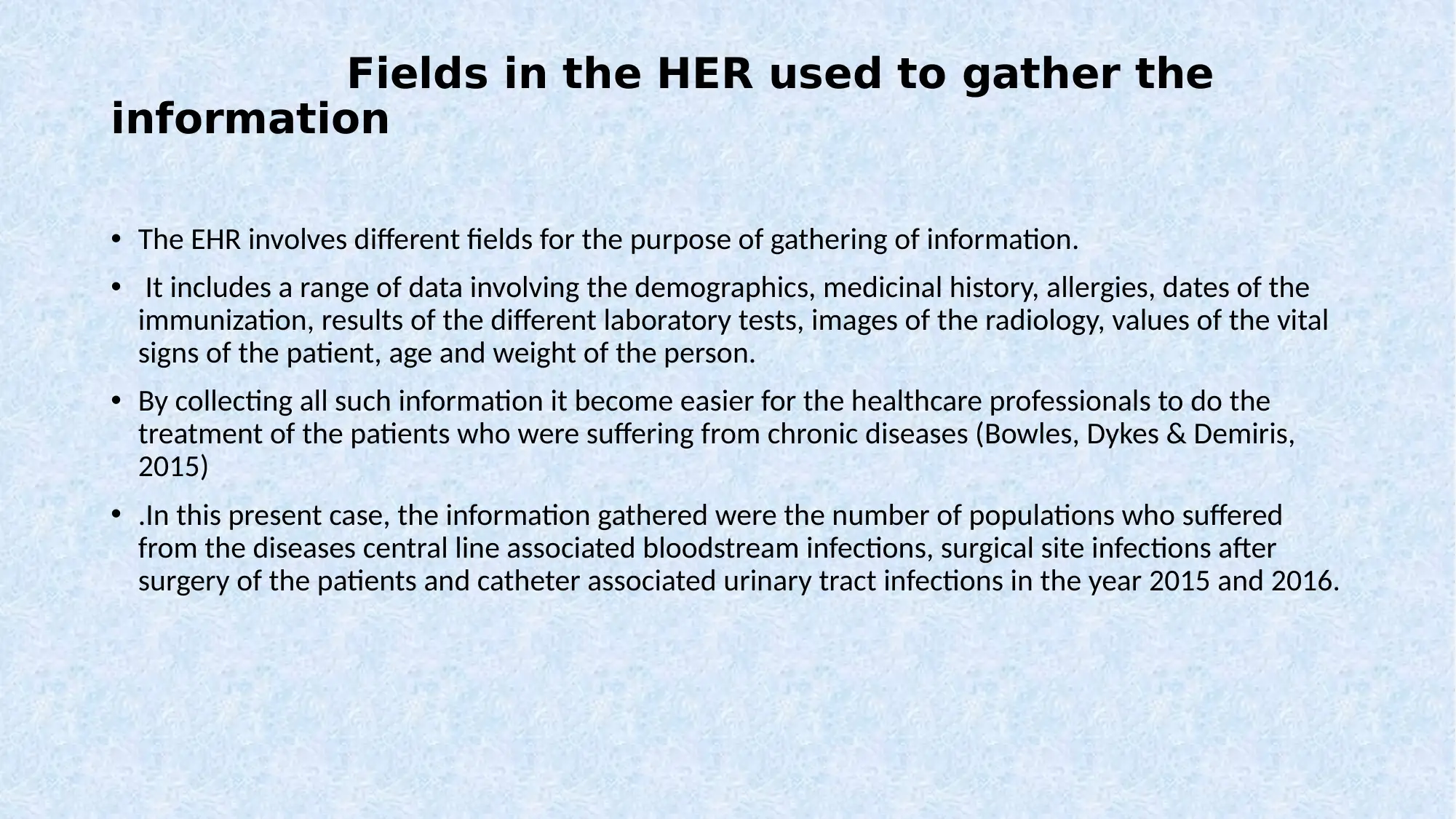
Fields in the HER used to gather the
information
• The EHR involves different fields for the purpose of gathering of information.
• It includes a range of data involving the demographics, medicinal history, allergies, dates of the
immunization, results of the different laboratory tests, images of the radiology, values of the vital
signs of the patient, age and weight of the person.
• By collecting all such information it become easier for the healthcare professionals to do the
treatment of the patients who were suffering from chronic diseases (Bowles, Dykes & Demiris,
2015)
• .In this present case, the information gathered were the number of populations who suffered
from the diseases central line associated bloodstream infections, surgical site infections after
surgery of the patients and catheter associated urinary tract infections in the year 2015 and 2016.
information
• The EHR involves different fields for the purpose of gathering of information.
• It includes a range of data involving the demographics, medicinal history, allergies, dates of the
immunization, results of the different laboratory tests, images of the radiology, values of the vital
signs of the patient, age and weight of the person.
• By collecting all such information it become easier for the healthcare professionals to do the
treatment of the patients who were suffering from chronic diseases (Bowles, Dykes & Demiris,
2015)
• .In this present case, the information gathered were the number of populations who suffered
from the diseases central line associated bloodstream infections, surgical site infections after
surgery of the patients and catheter associated urinary tract infections in the year 2015 and 2016.
⊘ This is a preview!⊘
Do you want full access?
Subscribe today to unlock all pages.

Trusted by 1+ million students worldwide
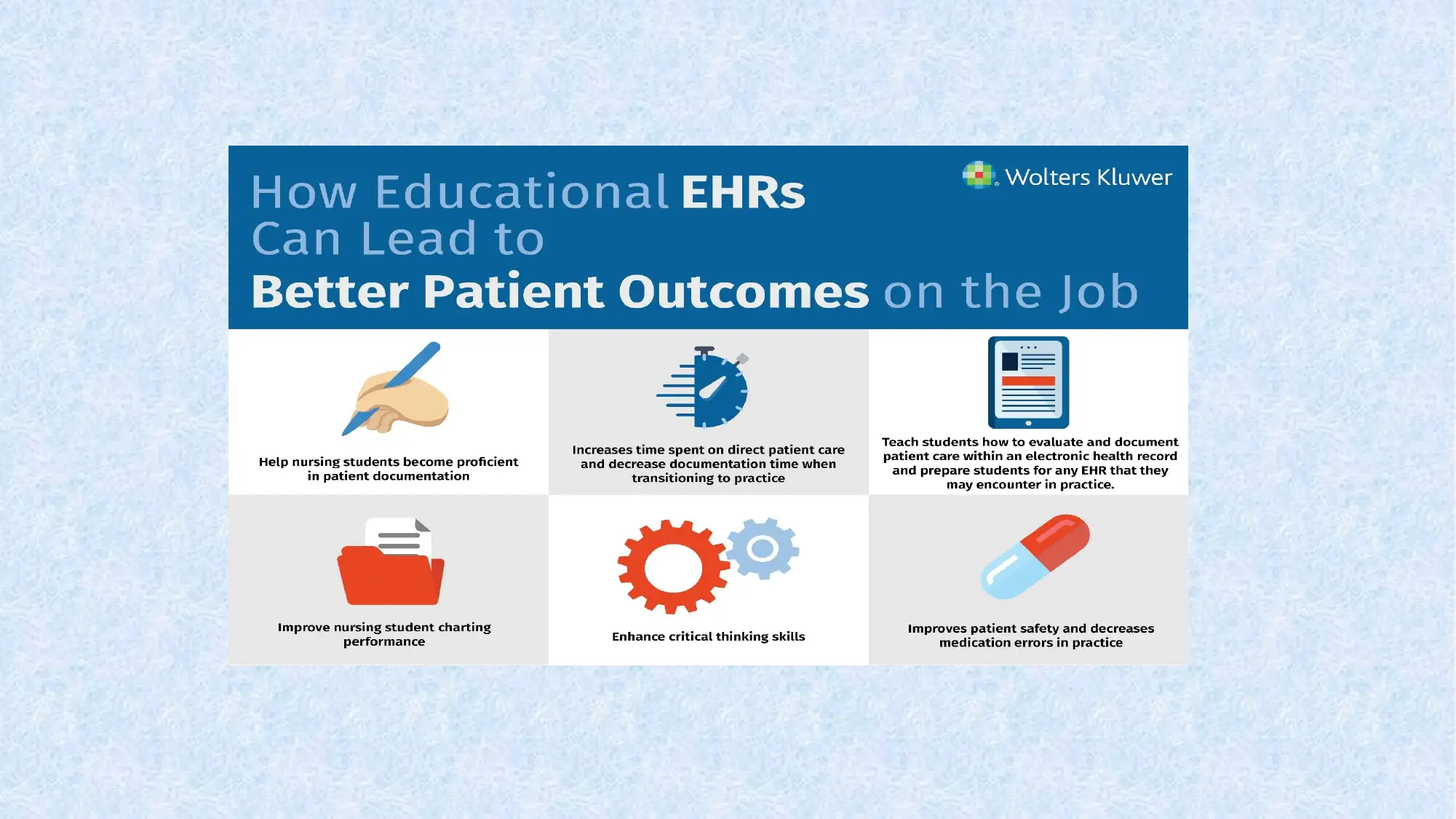
Paraphrase This Document
Need a fresh take? Get an instant paraphrase of this document with our AI Paraphraser
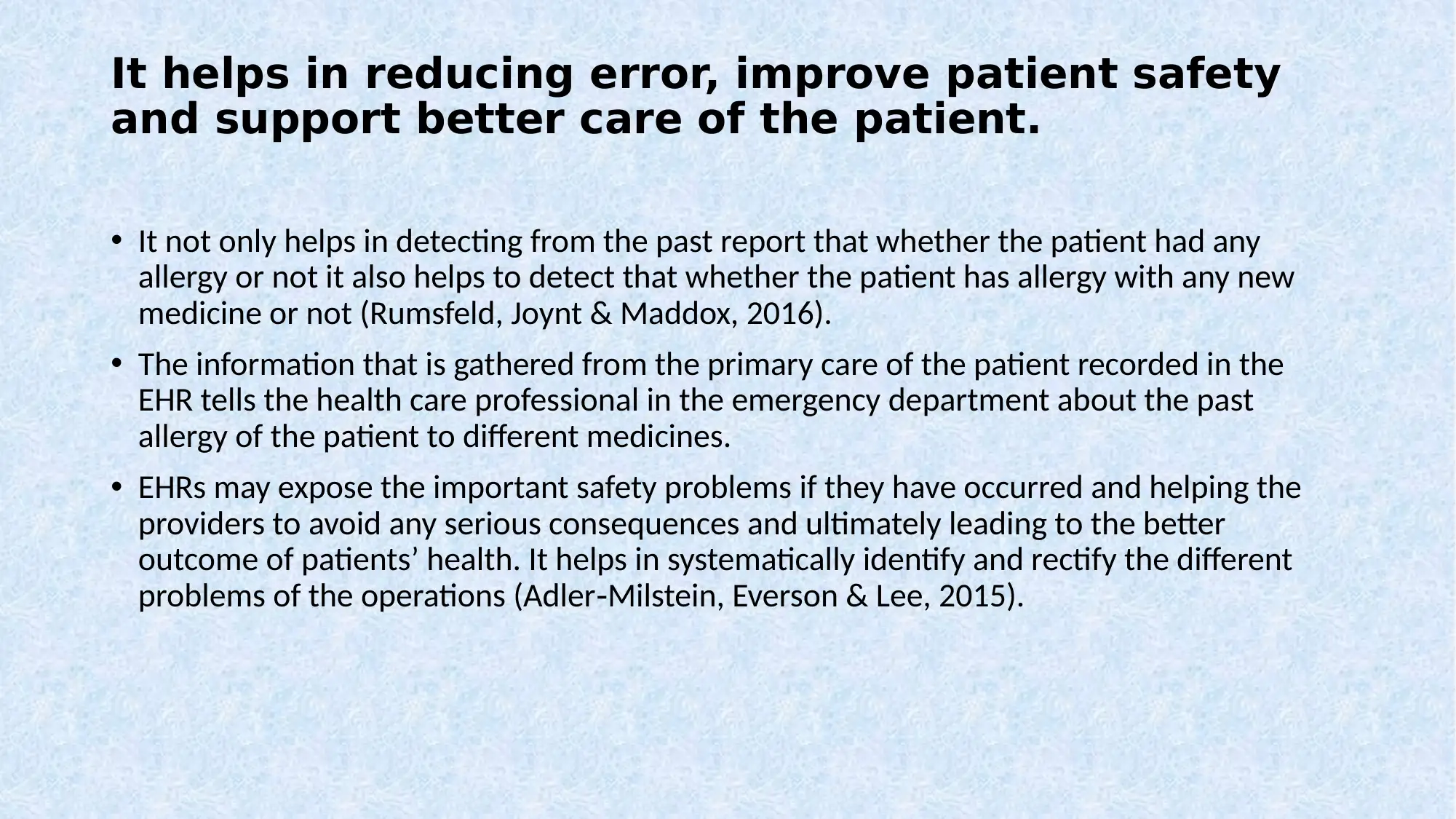
It helps in reducing error, improve patient safety
and support better care of the patient.
• It not only helps in detecting from the past report that whether the patient had any
allergy or not it also helps to detect that whether the patient has allergy with any new
medicine or not (Rumsfeld, Joynt & Maddox, 2016).
• The information that is gathered from the primary care of the patient recorded in the
EHR tells the health care professional in the emergency department about the past
allergy of the patient to different medicines.
• EHRs may expose the important safety problems if they have occurred and helping the
providers to avoid any serious consequences and ultimately leading to the better
outcome of patients’ health. It helps in systematically identify and rectify the different
problems of the operations (Adler Milstein, Everson & Lee, 2015).‐
and support better care of the patient.
• It not only helps in detecting from the past report that whether the patient had any
allergy or not it also helps to detect that whether the patient has allergy with any new
medicine or not (Rumsfeld, Joynt & Maddox, 2016).
• The information that is gathered from the primary care of the patient recorded in the
EHR tells the health care professional in the emergency department about the past
allergy of the patient to different medicines.
• EHRs may expose the important safety problems if they have occurred and helping the
providers to avoid any serious consequences and ultimately leading to the better
outcome of patients’ health. It helps in systematically identify and rectify the different
problems of the operations (Adler Milstein, Everson & Lee, 2015).‐
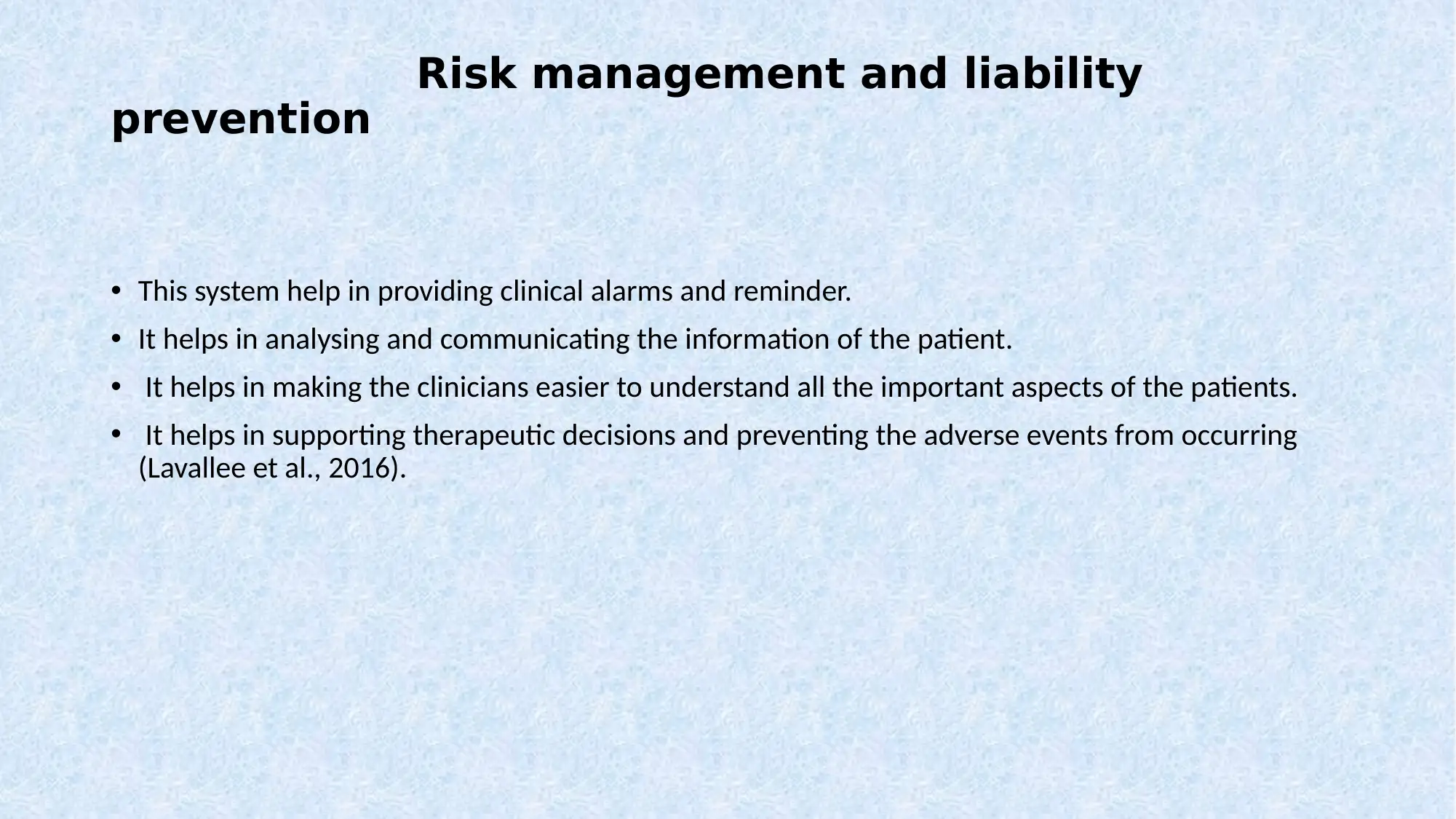
Risk management and liability
prevention
• This system help in providing clinical alarms and reminder.
• It helps in analysing and communicating the information of the patient.
• It helps in making the clinicians easier to understand all the important aspects of the patients.
• It helps in supporting therapeutic decisions and preventing the adverse events from occurring
(Lavallee et al., 2016).
prevention
• This system help in providing clinical alarms and reminder.
• It helps in analysing and communicating the information of the patient.
• It helps in making the clinicians easier to understand all the important aspects of the patients.
• It helps in supporting therapeutic decisions and preventing the adverse events from occurring
(Lavallee et al., 2016).
⊘ This is a preview!⊘
Do you want full access?
Subscribe today to unlock all pages.

Trusted by 1+ million students worldwide
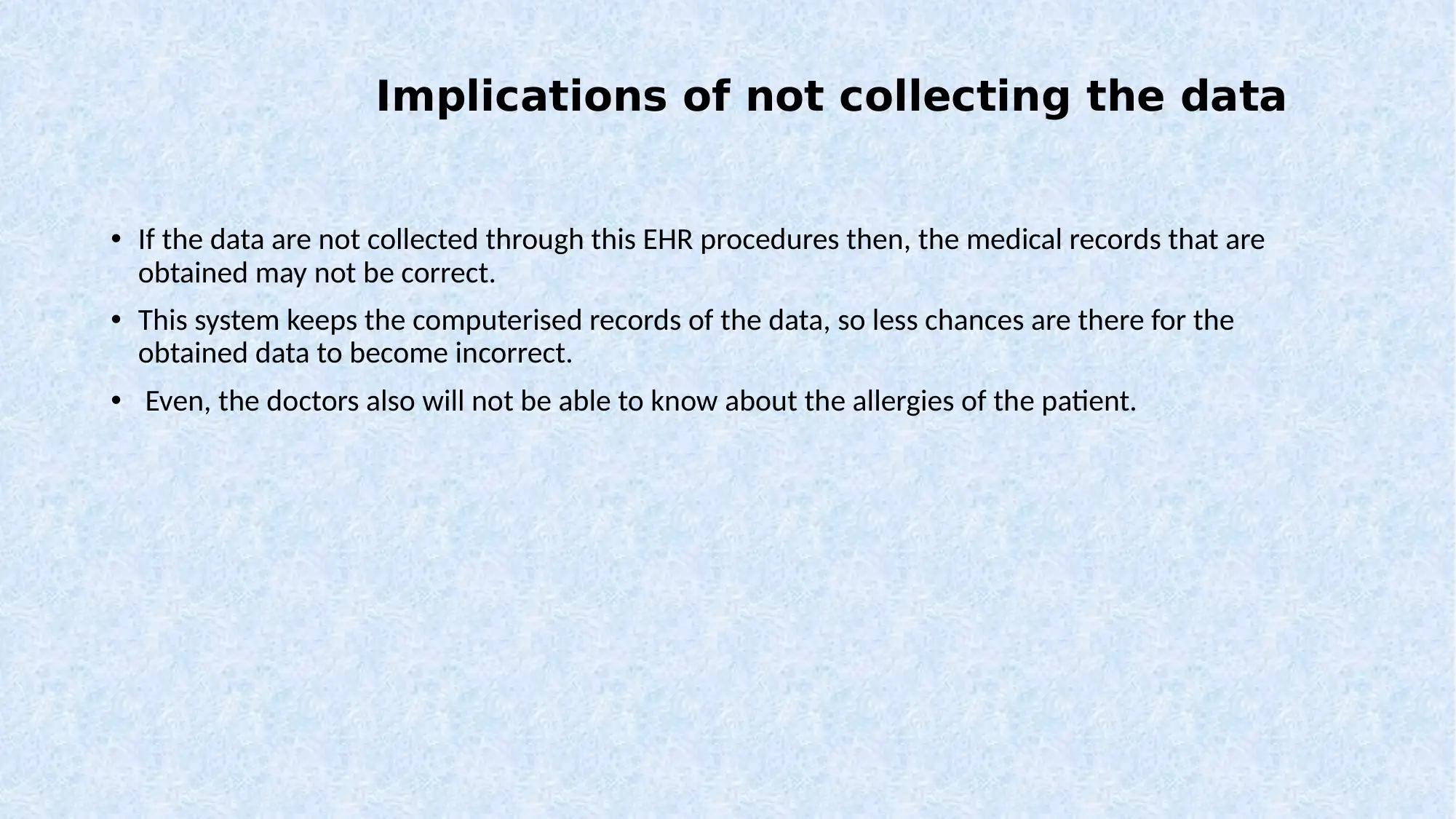
Implications of not collecting the data
• If the data are not collected through this EHR procedures then, the medical records that are
obtained may not be correct.
• This system keeps the computerised records of the data, so less chances are there for the
obtained data to become incorrect.
• Even, the doctors also will not be able to know about the allergies of the patient.
• If the data are not collected through this EHR procedures then, the medical records that are
obtained may not be correct.
• This system keeps the computerised records of the data, so less chances are there for the
obtained data to become incorrect.
• Even, the doctors also will not be able to know about the allergies of the patient.
Paraphrase This Document
Need a fresh take? Get an instant paraphrase of this document with our AI Paraphraser
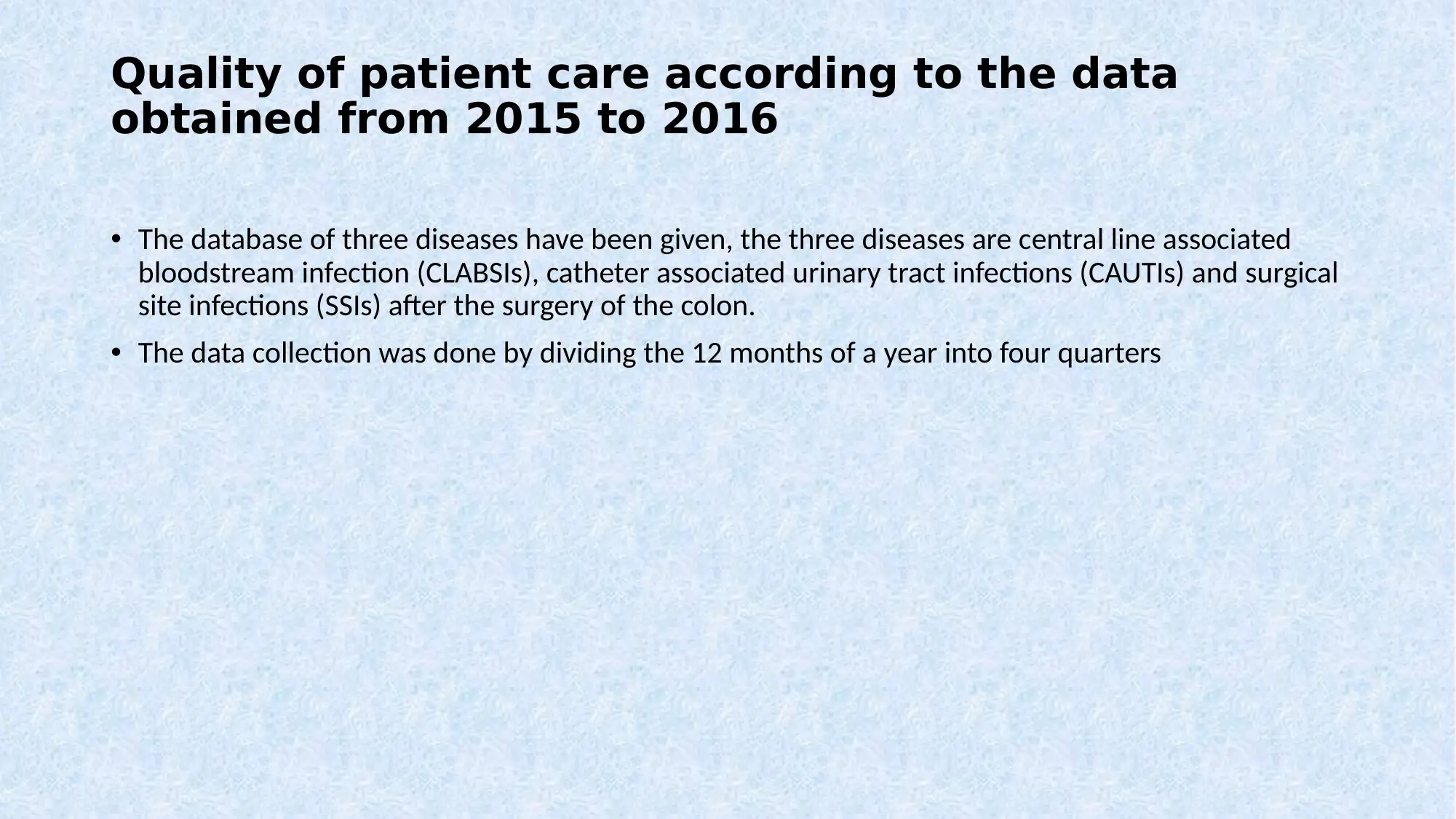
Quality of patient care according to the data
obtained from 2015 to 2016
• The database of three diseases have been given, the three diseases are central line associated
bloodstream infection (CLABSIs), catheter associated urinary tract infections (CAUTIs) and surgical
site infections (SSIs) after the surgery of the colon.
• The data collection was done by dividing the 12 months of a year into four quarters
obtained from 2015 to 2016
• The database of three diseases have been given, the three diseases are central line associated
bloodstream infection (CLABSIs), catheter associated urinary tract infections (CAUTIs) and surgical
site infections (SSIs) after the surgery of the colon.
• The data collection was done by dividing the 12 months of a year into four quarters
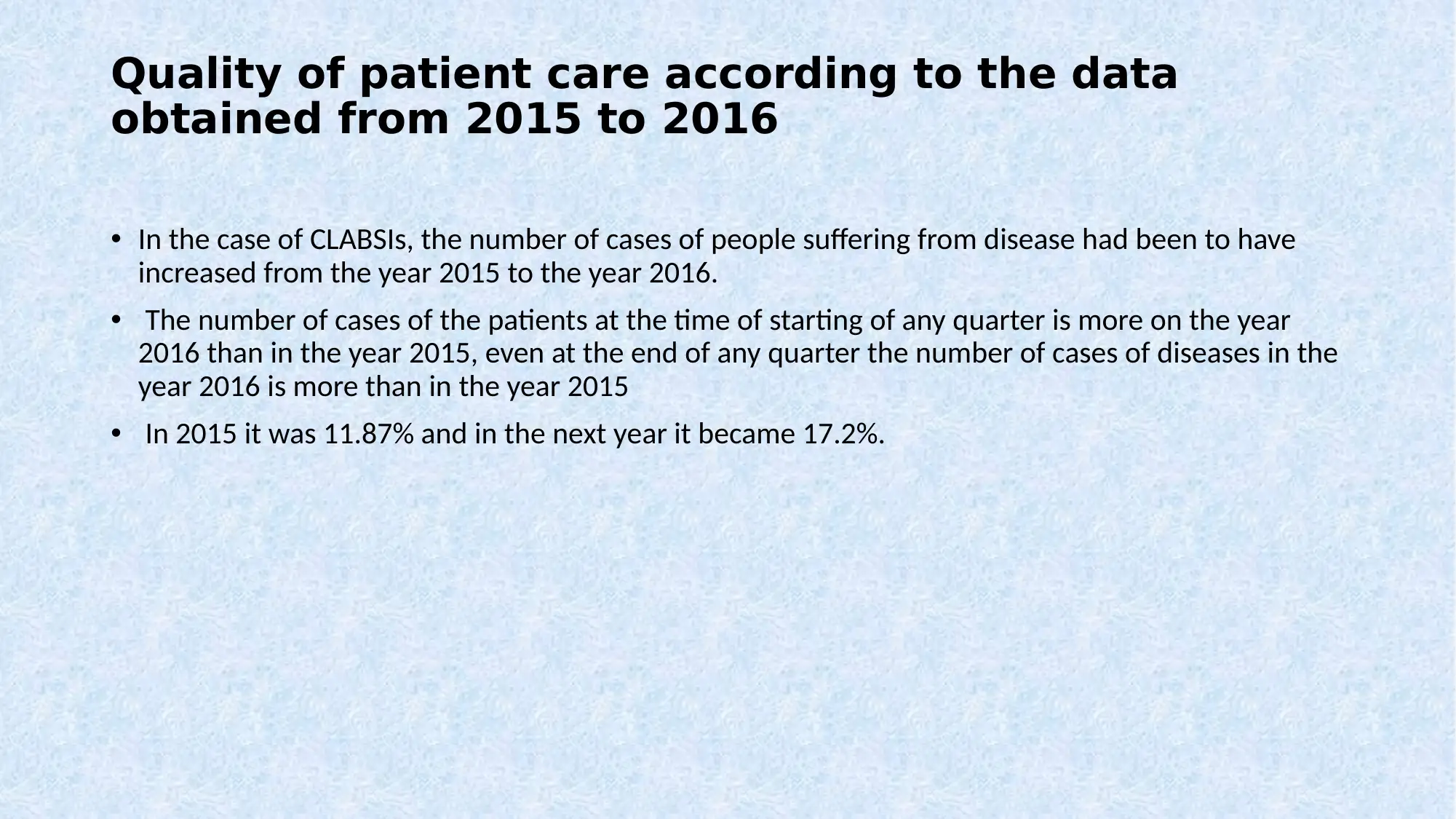
Quality of patient care according to the data
obtained from 2015 to 2016
• In the case of CLABSIs, the number of cases of people suffering from disease had been to have
increased from the year 2015 to the year 2016.
• The number of cases of the patients at the time of starting of any quarter is more on the year
2016 than in the year 2015, even at the end of any quarter the number of cases of diseases in the
year 2016 is more than in the year 2015
• In 2015 it was 11.87% and in the next year it became 17.2%.
obtained from 2015 to 2016
• In the case of CLABSIs, the number of cases of people suffering from disease had been to have
increased from the year 2015 to the year 2016.
• The number of cases of the patients at the time of starting of any quarter is more on the year
2016 than in the year 2015, even at the end of any quarter the number of cases of diseases in the
year 2016 is more than in the year 2015
• In 2015 it was 11.87% and in the next year it became 17.2%.
⊘ This is a preview!⊘
Do you want full access?
Subscribe today to unlock all pages.

Trusted by 1+ million students worldwide
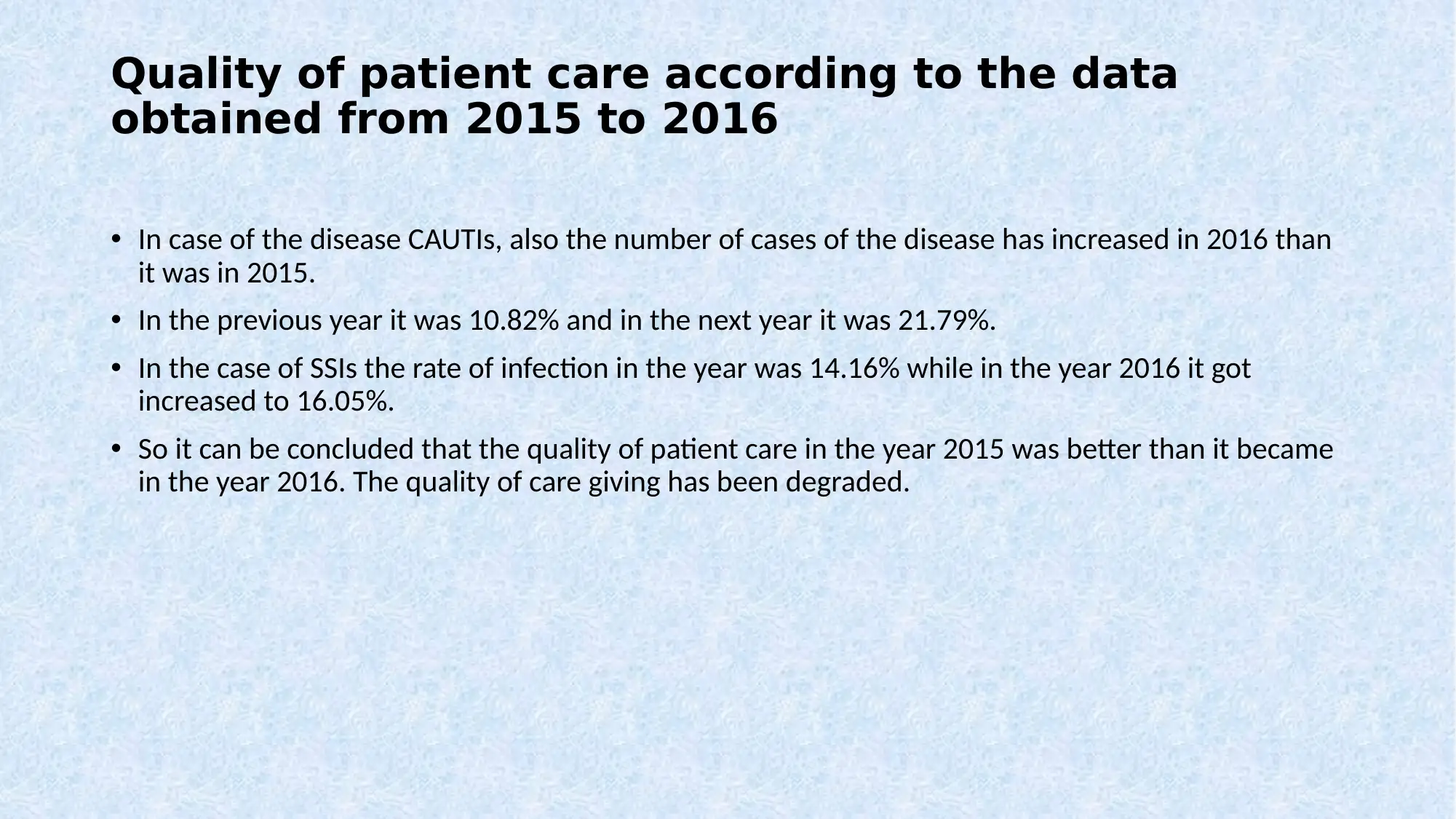
Quality of patient care according to the data
obtained from 2015 to 2016
• In case of the disease CAUTIs, also the number of cases of the disease has increased in 2016 than
it was in 2015.
• In the previous year it was 10.82% and in the next year it was 21.79%.
• In the case of SSIs the rate of infection in the year was 14.16% while in the year 2016 it got
increased to 16.05%.
• So it can be concluded that the quality of patient care in the year 2015 was better than it became
in the year 2016. The quality of care giving has been degraded.
obtained from 2015 to 2016
• In case of the disease CAUTIs, also the number of cases of the disease has increased in 2016 than
it was in 2015.
• In the previous year it was 10.82% and in the next year it was 21.79%.
• In the case of SSIs the rate of infection in the year was 14.16% while in the year 2016 it got
increased to 16.05%.
• So it can be concluded that the quality of patient care in the year 2015 was better than it became
in the year 2016. The quality of care giving has been degraded.
Paraphrase This Document
Need a fresh take? Get an instant paraphrase of this document with our AI Paraphraser
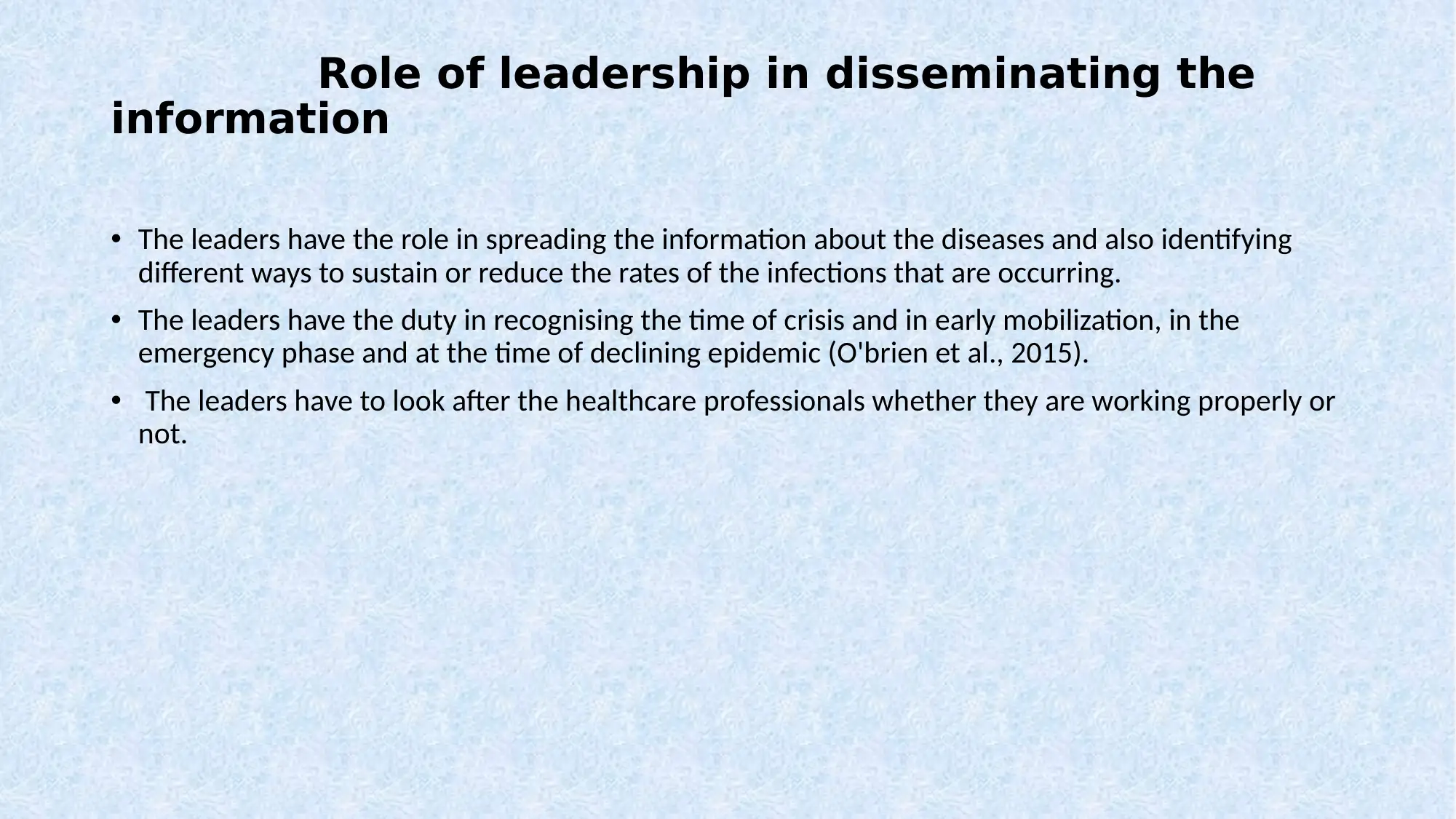
Role of leadership in disseminating the
information
• The leaders have the role in spreading the information about the diseases and also identifying
different ways to sustain or reduce the rates of the infections that are occurring.
• The leaders have the duty in recognising the time of crisis and in early mobilization, in the
emergency phase and at the time of declining epidemic (O'brien et al., 2015).
• The leaders have to look after the healthcare professionals whether they are working properly or
not.
information
• The leaders have the role in spreading the information about the diseases and also identifying
different ways to sustain or reduce the rates of the infections that are occurring.
• The leaders have the duty in recognising the time of crisis and in early mobilization, in the
emergency phase and at the time of declining epidemic (O'brien et al., 2015).
• The leaders have to look after the healthcare professionals whether they are working properly or
not.
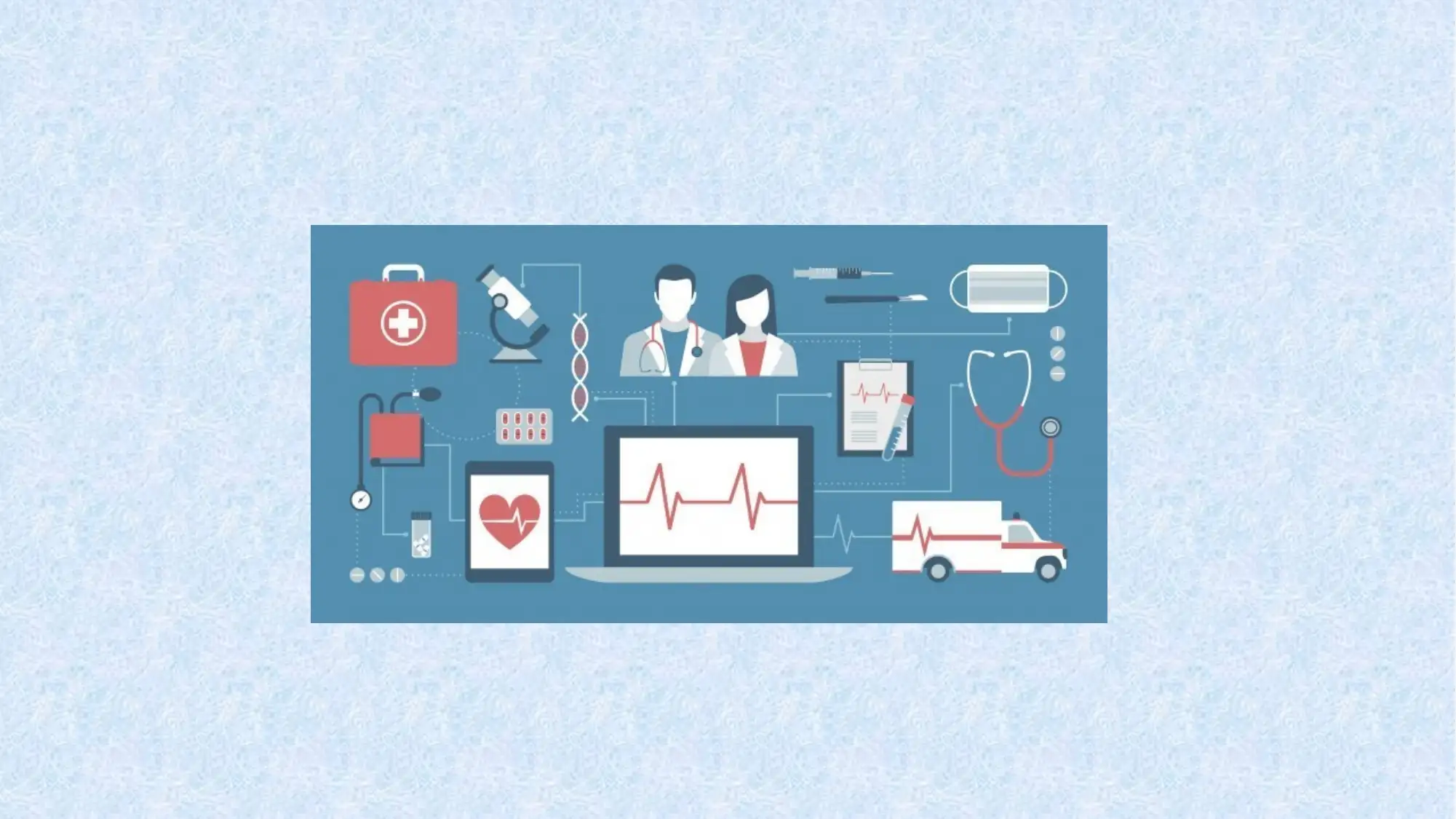
⊘ This is a preview!⊘
Do you want full access?
Subscribe today to unlock all pages.

Trusted by 1+ million students worldwide
1 out of 15
Related Documents
Your All-in-One AI-Powered Toolkit for Academic Success.
+13062052269
info@desklib.com
Available 24*7 on WhatsApp / Email
![[object Object]](/_next/static/media/star-bottom.7253800d.svg)
Unlock your academic potential
Copyright © 2020–2025 A2Z Services. All Rights Reserved. Developed and managed by ZUCOL.





